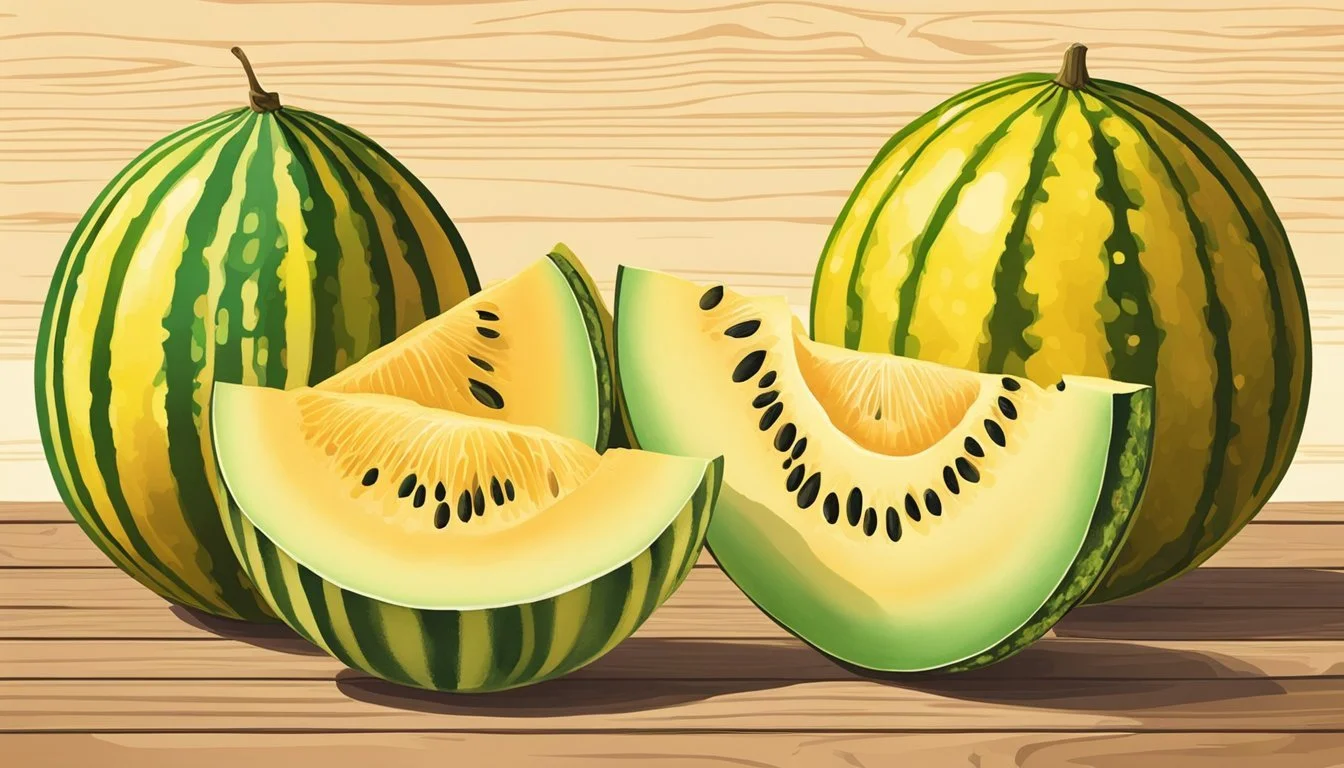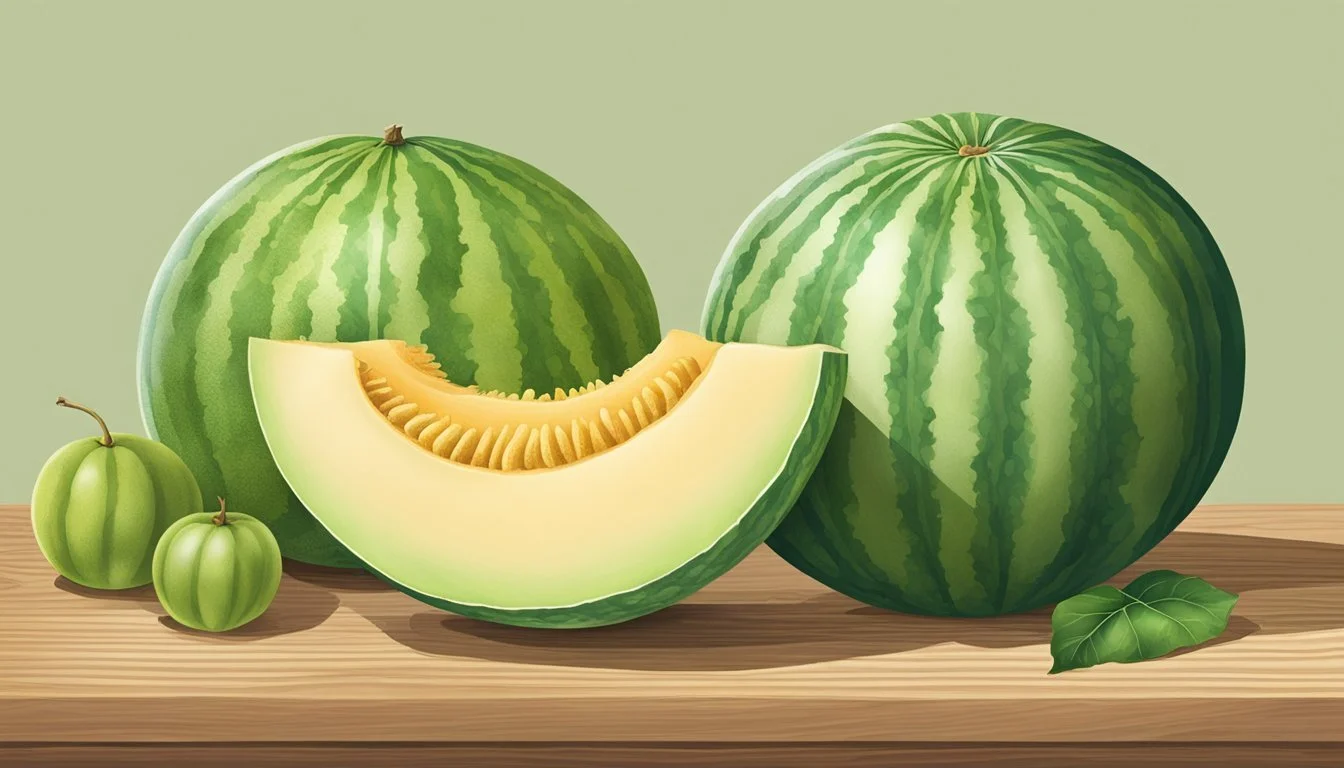How to Tell if a Crenshaw Melon is Ripe
Selecting the Sweetest Fruit
Selecting a perfectly ripe Crenshaw melon can be the key to enjoying its peak flavor and juiciness. This type of melon, known for its sweet and tender flesh, is a variety of muskmelon that has gained popularity for its rich taste. Understanding when a Crenshaw melon is ready to eat not only enhances your culinary experience but also ensures you get the most out of this delightful fruit.
Ripeness is indicated by a few telltale signs. The skin of a ripe Crenshaw melon transitions to a yellow or deep orange hue, providing a visual cue to its readiness. A subtle softness at the larger end of the melon, combined with a noticeable sweet fragrance near the stem, also suggests that the melon has reached optimal ripeness. By observing these characteristics, you can confidently select a Crenshaw melon that is sure to be delicious.
Key Takeaways
Choose Crenshaw melons with a deep orange to yellow skin for optimal ripeness.
A ripe melon should be slightly soft at the large end and emit a sweet aroma near the stem.
The peak flavor of Crenshaw melons can be enjoyed by identifying these signs and using proper storage techniques.
Understanding Crenshaw Melons
Crenshaw melons, with their distinctive size and flavor, represent an appreciated variety within the muskmelon family. Grasping their origin and characteristics is essential for any gardener or consumer interested in this specific type of melon.
Origin and Characteristics
Originating as a hybrid between the casaba and Persian melon, the Crenshaw (Cucumis melo 'Crenshaw') is known for its large, oval to pear-like shape and sweet, juicy flesh. The melons are typically ready for harvest in a garden setting when they reach a substantial weight, usually 5 to 10 pounds. An interesting note about Crenshaw melons is that they are fast-maturing varieties that thrive in warm conditions, making them a rewarding choice for many gardeners.
Size: 5 to 10 pounds
Shape: Oval to pear-like
Color: Pale yellow skin when immature, ripening to a deep golden
Texture: Smooth with a slight softness upon ripeness
Flavor: Sweet and juicy
Crenshaw Melon Varieties
Though the Crenshaw melon itself can be considered a variety deriving from other melon species, it shares the stage with other renowned types like the honeydew, cantaloupe, and casaba. Each has distinct characteristics regarding size, shape, and color:
Honeydew: Round shape, typically pale green flesh, and a smooth white rind.
Cantaloupe: Netted skin, usually more circular, with a deeply fragrant orange flesh.
Casaba: Less sweet, with a yellow rind and an elongated shape.
These varieties, along with Crenshaw melons, make up an important part of the melon family, often featured in gardens and kitchens for their diverse textures and flavors. When selecting a Crenshaw, consumers and gardeners alike look for a melon that rests heavily in their hands, signaling a richness of water and sugar content within.
Growing Crenshaw Melons
When cultivating Crenshaw melons, growers must prioritize appropriate climate conditions, meticulous planting and ongoing care, as well as adopt precise harvesting techniques to ensure a fruitful yield.
Ideal Growing Conditions
Crenshaw melons thrive in warm climates and require a growing site with well-drained soil. The optimal soil pH should be between 6.5 to 7.5, and the soil can be improved by incorporating sandy loam with plenty of organic matter. Fabric row covers or black plastic tarps can be used to retain soil warmth. Additionally, establishing melons on trellises can optimize space and reduce disease pressure by improving air circulation around the vines.
Planting and Care
Plant Crenshaw seeds in the garden after the last frost date has passed and when the soil temperature consistently reaches between 80-90 degrees Fahrenheit. To aid germination, maintain the soil's moisture levels and consider using a heat mat if necessary. After germination, the seedlings may be transplanted with care. Space plant sets 4-6 feet apart, and use mulch to preserve soil moisture. As the melons grow, watermelon growers can apply similar care techniques, such as watering deeply while avoiding wetting the leaves to prevent fungal diseases.
Harvesting Techniques
Harvesting requires observation to determine the ripeness of the Crenshaw melons. Examine the color; it should shift to a golden hue. Also, a properly ripe melon emits a rich, melony smell and the rind near the stem softens. The melon should detach easily from the vine, indicating it is ready for harvest. The growing season for Crenshaw melons varies, but signs of ripeness are consistent indicators it is time to gather your crop.
Identifying Ripeness
When selecting a ripe Crenshaw melon, it is essential to evaluate its external appearance, physical firmness, and aroma. These attributes are reliable indicators of a melon's ripeness and overall quality.
External Indicators
The color of the Crenshaw melon is a telling factor in its ripeness. A ripe Crenshaw melon typically exhibits a deep orange to yellow skin coloration. Look for a uniform hue that suggests the melon has ripened evenly. Areas of green may indicate that the melon is not fully mature. Moreover, the rind should be smooth but with a certain waxy feel when the melon is ready to eat.
Physical Tests
To further determine ripeness, one can perform a few simple physical tests. Weight is a good indicator; a ripe melon should feel heavy for its size, suggesting a juicy interior. Gently press on the melon's rind, especially at the larger end. A ripe melon will have a slight give, indicating softness without the presence of soft spots which may signify overripeness or rot. Additionally, the stem should show signs of separation from the vine, which typically occurs as the melon matures.
Sense-Based Assessment
The melon's aroma is a critical gauge of ripeness. A ripe Crenshaw melon emits a sweet and fragrant aroma, particularly near the stem end. This sense-based assessment should not be overlooked, as it complements the tactile and visual evaluations. Lastly, conduct a sound test by tapping on the melon; a hollow sound is indicative of a ripe melon, whereas a dull sound may imply that it is not yet ripe.
Selecting a ripe Crenshaw melon involves careful observation and tactile examination to ensure the fruit is at the peak of its flavor and texture.
Handling and Storage
In this section, we'll focus on the best practices to select the perfect Crenshaw melon, how to store it effectively, and identify common signs of spoilage. Attention to these details ensures optimum taste and maximum shelf life.
Selecting the Perfect Melon
When choosing a Crenshaw melon, several attributes indicate ripeness and quality. Ensure the melon feels heavy for its size, a signifier of good density and juiciness. The melon should have a slightly elongated shape and a smooth skin. A ripe melon's color should be a deep orange to yellow hue. Slight softness at the blossom end is normal, but avoid melons with bruises or overly soft spots that may indicate spoilage.
Proper Storage Techniques
Ripeness at the time of purchase will determine the storage method:
Not Yet Ripe: Store at room temperature away from direct sunlight to continue the ripening process.
Ripe:
Refrigerate promptly to slow down ripening.
Store in the crisper drawer to maintain ideal humidity.
Always keep the melons away from ethylene-producing fruits to prevent over-ripening. Crenshaw melons, once ripe, should be consumed within a week to preserve freshness.
Common Signs of Spoilage
Crenshaw melons are prone to spoilage if not stored correctly. Telltale signs include:
Texture: Soft spots beyond the slight yield at the blossom end can suggest rot.
Smell: A sour or fermented aroma is a clear indicator.
Appearance: Discoloration, mold, or bruises suggest the melon is past its prime.
It is best to discard melons showing these signs to avoid the risk of consuming spoiled produce.
Enjoying Crenshaw Melons
Choosing a ripe Crenshaw melon ensures you'll enjoy its optimal flavor and texture. Here's how to relish this delightful melon, from preparing it to understanding its health benefits.
Preparation and Serving Suggestions
Once you've selected a ripe Crenshaw melon, characterized by soft, sweet, and juicy flesh, it's best to consume it at peak ripeness for a delightful flavor experience. The melon's orange flesh can be easily cut into cubes or scooped out with a melon baller. Here are some serving suggestions:
Fruit Salads: Combine Crenshaw melon pieces with other fruits such as berries or citrus for a colorful and refreshing salad.
Smoothies: Blend melon chunks with yogurt or juice to create a hydrating smoothie.
Desserts: Enhance desserts with its sweet flesh. It pairs wonderfully with a drizzle of honey or a scoop of ice cream.
With Proteins: It complements savory dishes like prosciutto-wrapped melon slices or a salad topped with flaked salmon.
For those wondering about the seeds, Crenshaw melon seeds can be removed easily with a spoon.
Nutritional Benefits
Crenshaw melons aren't just tasty—they're also packed with health-promoting vitamins and minerals:
Vitamins: A great source of Vitamin C, crucial for boosting the immune system.
Hydration: High water content aids in hydration, making it perfect for replenishing fluids in the body.
Antioxidants: Contains antioxidants, which help protect the body from free radicals.
Potassium: Rich in potassium, beneficial for maintaining healthy blood pressure levels.
Dietary Fiber: The presence of dietary fiber supports digestion and may contribute to a healthy diet.
Remember, incorporating ripe Crenshaw melons into your diet can add a burst of sweetness and texture to your meals while offering a variety of nutritional advantages.
Frequently Asked Questions
This section provides detailed insights into the ripening process of Crenshaw melons and addresses common issues encountered when determining their ripeness.
Ripening Process
How long does it take for a Crenshaw melon to ripen? A Crenshaw melon generally reaches ripeness after 90 to 100 days from germination. Throughout the growing season, it's essential to monitor the melon's progress. Melons grown outdoors benefit from natural sunlight and tend to ripen predictably during warm conditions.
What signs indicate a Crenshaw melon is ripe? A ripe Crenshaw melon typically exhibits:
A change in the skin color to a deep orange to yellow hue
Softening at the blossom end
A characteristic sweet aroma, especially near the stem end
Heavy weight for its size
A hollow sound when tapped on the top, indicating a ripe, juicy interior
Troubleshooting Common Issues
What if a Crenshaw melon is not ripening? When indoors or in a cooler climate, a Crenshaw melon might ripen more slowly. To encourage ripening, one can place the melon in a warm, well-ventilated area. However, once harvested, the melon will not become sweeter but may soften slightly.
How can one deal with an underripe or overripe melon? An underripe melon is often hard and lacking in flavor, while an overripe one may become mushy or begin to ferment. If a Crenshaw melon is slightly underripe, letting it sit at room temperature for a day or two might improve its texture, though not sweetness. Overripe melons should be consumed quickly, ideally in smoothies or as part of a dessert where texture is less critical.
What are the signs of wilting or disease in Crenshaw melons? Wilting leaves or stems during the growing season can indicate a water issue or disease. An underripe melon that's wilting or has a crunchy texture when cut open may not have received adequate water or nutrients. It's crucial to maintain consistent soil moisture and good plant health to avoid these issues.



